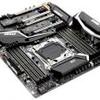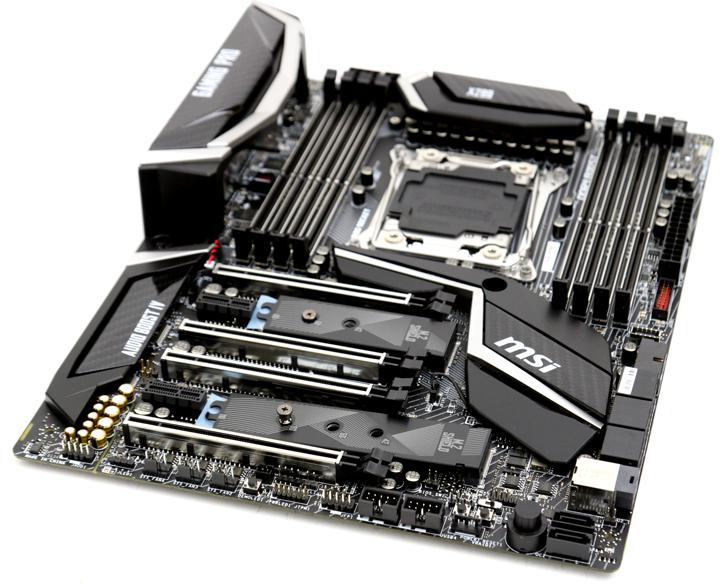Final Words & Conclusion
Final words & conclusion
MSI is once again building on the strong foundation they have set and introduced ever since a year or three ago. That means they will offer a feature-rich and well-designed motherboard. There is little you would disagree on when looking at this puppy. It works well also with blistering fast memory options and even two M.2 slots. Btw we'll address this later on in the conclusion, but please do keep in mind that only the 10-core processor offers 44 PCie-Express lanes, something to keep in mind if you opt for multi-GPU and two x4 M.2 SSD units. The design overall is terrific in its black/grey/chome look (though looks are personal and thus a subjective preference). Once we received the latest BIOS, the board performs really well and stable - MSI has created an easy to tweak platform with their UEFI BIOS. Features wise it's as good as it is going to get in this price segment. The LED design is simple yet intricate. So yeah, it's a pretty lovely motherboard.
Performance & tweaking
For our testing we used the MSI X299 motherboard and I'd rate the new 10-core CPU part as "very good" for the results as tested. Temps remain OK'ish at best though (depending on choice of cooling) temperatures when the CPU is overclocked with added voltage definitely are a challenge opposed to the last-gen Broadwell-E. Realistically if you already are on that or a Haswell-E platform, really there's little to get excited about upgrade wise. At the OC level you are looking at up-to 1.35V needed on that CPU core (depending on your frequency target). We however have been using an ES sample so I cannot say anything conclusive on the final retail products. The infrastructure that X299 offers is easy to use, you increase the CPU voltage and multiplier and you are good to go. Another plus for the Intel platform is that over the years they have been able to refine their memory controllers, pop in anything XMP 2.0 and you have a 90% chance it'll work straight out of the box with very fast memories. However, the effect of fast clocked memory is far less significant for Intel opposed to AMD Ryzen. Also with quad-channel memory available as an option, we'd always suggest to go with a nice affordable 2677 MHz kit, as bandwidth on quad-channel simply is not relevant to your gaming experience.
Power consumption
With ten cores you get a 140 Watt TDP processor, I do not believe for a second that value is correct. With the system at idle with a GeForce GTX 1080 installed / 16 GB memory / SSD and the X299 motherboard I hovered at roughly 75 Watts in IDLE. That's just fine really, but the load values are rather significant. When we stressed the processor in a 100% run we reach roughly 250 to 300 Watts with this is a 10-core part. So we go from 75 Watts towards 300, that's 225 Watts in my book. When we game we hover at ~350 Watts with the GeForce GTX 1080, but obviously that factor is dependant on the type of graphics card you use of course and, sure, most games certainly do not utilize the 10 CPU cores.
Some issues
I won't lie, the past two weeks with the Core i7 7900X and the X299 boards I have tested have been a challenge. Memory XMP profiles would not stick, power consumption with one BIOS was OK, the other through the roof. But, most of all, the processor performance was all over the place. We've seen perf differences of up-tp 20% in-between just different motherboards.
MSI however, with their latest BIOS seem to have found a state of equilibrium. My biggest fight over the two weeks was ironically game performance, it was severely lacking. Example: a platform like this should run Rise of the Tomb Raider at ~140 FPS at 1080p on a GeForce GTX 1080. We'd end up at 90~100 FPS. And that problem occurred with pretty much all games. I have been discussing this with the motherboard partners (as yes, it is widespread) and we all agreed, it has everything to do with 'hardware P states' that Intel recommends to leave enabled. Intel recommends certain power states to keep the TDP in line. For most overall tests that worked fine, but the toll on game performance was abysmal. Days before this launch, MSI however released and provided a new BIOS, this restored the performance to what it needs to be. But as you have been able to see, the power consumption is certainly a bit on the high-side. In the end though, the performance is there, but we do expect several BIOS updates that will have an effect on performance overall, in gaming and on power-consumption.
Bothersome
Two things I find to be significantly bothersome, this launch is clouded by too many architectures and processors that really haven't been released. You can choose from 4 to 10 cores, which is fine. However Intel went big with an announcement on 12, 14, 16 and even a 2000 USD 18-core part. The 12-core version should see the light next month, however the last three are nowhere to be found and I am starting to doubt that you'll see them anytime soon. The latest indication is October. Sure, perhaps a review here and there to show off that Intel can do it. But retail availability? I don't know man. So this is all cloudy and confusing really. But hey, this article hopefully cleared that up or at least made the topic more understandable. A bit more bothersome: we have to discuss PCI-Express lanes, as honestly here is Intel just goofing up. Here is the breakdown:
- Kaby Lake-X quad core gets 16 PCI-Express Lanes 3.0
- Skylake-X six and eight core procs get 28 PCI-Express Lanes 3.0
- Skylake-X ten core procs get 44 PCI-Express Lanes 3.0 Gen 2
DDR4 Memory
Ever since Haswell-E was released along came DDR4 memory. With Skylake-X DDR4 may be clocked a notch faster at 2,677 MHz. Honestly, if you pick up some nice 2,133 MHz DIMMs, at quad-channel they'll offer more than plentiful bandwidth. A 3,200 MHz kit for example is far more expensive and does offer better bandwidth but the performance increases in real-world usage will be hard to find. Unless you transcode videos over the processor a lot. DDR4 mostly was released for lower voltages and higher frequencies. 2,133 MHz CL 14 or CL 15 memory in combo with quad-channel will already get you to 50~60 GB/sec. While impressive to observe for gaming you will not notice huge performance improvements with high memory bandwidth, but with content creation and video transcoding this kind of bandwidth certainly does make a difference. As always, my advice would be to go with lower clocked DDR4 memory with decent timings, but get more of it. Don't go for 8 GB, get four DIMMs and in total a minimum of 16 GB. And yeah, if you do not care about spending money, check the test page with the G.Skill RGB DIMMs at 3600 MHz, that is brilliant stuff though.
The bottom line
The MSI X299 Gaming Pro Carbon AC is a platform that is going to be nice if you pair it with the right processor. Initially I do expect the board partners to issue a good number of firmwares/BIOSes as honestly, the platform does not feel as finished and refined as X99 is. But in hindsight, X99 when it was released experienced a similar improvement curve. It was merely 4 days before launch that MSI supplied a BIOS that I considered to be good enough for a proper review. It will be an excellent platform, that I am certain of. Now I can only speak for the 10-core processor, but Intel however is looking at a processor series that runs hot and when fully utilized, consumes significant amounts of power. So you do need to get your cooling in order, we'd recommend a proper LCS cooler, or preferably a proper liquid cooling kit, especially if you plan to tweak. Talking about tweaking, we reached 4.8 GHz on all cores, which is a significant step upwards from Broadwell-E (10-core 6950X). Since Intel allows per core tweaking, my advice would be to explore a little further, set say 4 cores at 4.8 GHz and the rest at 4.3 GHz. This might save you on power consumption, likely a lower voltage and thus the end result also is a processor that would run a bit cooler. It's just a tip though.
The MSI X299 Gaming Pro Carbon AC motherboard, overall, simply put is lovely. It's feature rich, has an incredible nice dark design and is well built with top notch components. Features wise this kit offers it all, the many SATA 6 Gbps ports, the Intel Ethernet jacks and the 7.1 channel HD audio. Exceptional was the AC WIFI btw, very good results there. The motherboard is multi-GPU ready (but keep my remarks on available processors and PCIe lanes in mind) and then add to all this features like on-board buttons, pre-overclock modes and diagnostic LEDs, fantastic design and configurable LED lit heatsinks, USB 3.1 Gen, SATA3, easy overclocking and sure, the design and component selection. All these features do give the product a bit of a steep price premium, € 359,- / 349 USD. We have not tested many X299 motherboards just yet, but I know the MSI X299 Gaming Pro Carbon AC motherboard would easily remain in the top three choices. It is an exciting year in the many threaded HEDT processor market alright.
Handy related downloads:
- Sign up to receive a notice when we publish a new article
- Or go back to Guru3D's front page.



